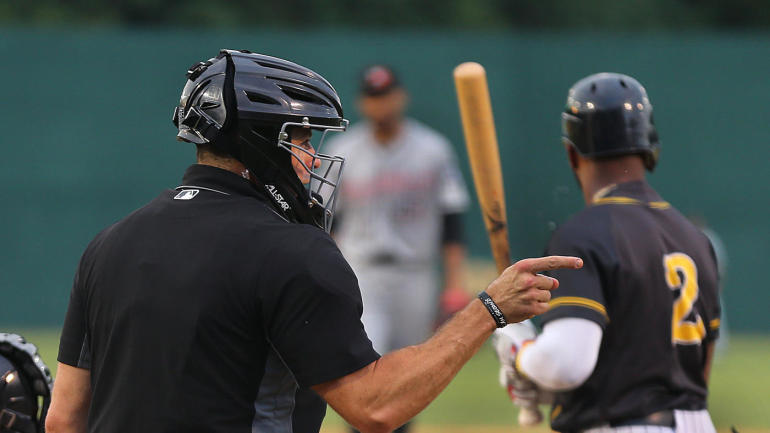
The MLB recently announced that the Automated Ball-Strike system, or ABS, will be used to call balls and strikes for Triple-A games in 2022. This announcement drastically increases the scope of ABS implementation, and demonstrates that the MLB is serious about determining its viability for use at the Major League level in the not so distant future.
ABS was first triled in 2019 in the independent Atlantic League, and later more thoroughly in the Arizona Fall League, but the onset of Covid-19 in 2020 derailed the ability to test the system, as Minor League Baseball was shut down. Its use in Triple-A, the final stepping stone in a player’s route to the major leagues, is a huge step up the baseball ladder for ABS, and will mark the system’s first real extended shakedown and evaluation in meaningful games.
Implementing an automated strike zone comes with a plethora of challenges and controversies beyond the use of a normal replay system. In addition to tackling the technological task of creating an accurate system that accounts for varying heights of players among other variables, its very existence will come with the consequences of changing the way the game is played, and risk the jobs of players and umpires.
The MLB was the last major American sports league to adopt replay review, as it failed to install a full system until 2014, almost thirty years after the NFL, and that is no coincidence. Because of the way baseball champions its history, making changes to the sport can be very difficult, and a sizable change like ABS could shake up baseball to its very core.
For one, the human element of umpiring would be removed. Names like Joe West, C.B. Bucknor, and Angel Hernandez are synonymous with baseball, for better or for worse, and adopting ABS would likely bring an end to celebrity umpires, beloved, or bemoned by fans and players. Adjusting to an umpire and his zone is considered a necessary skill, with pitchers learning where they can get strikes called, and hitters learning where they need to defend. Great pitchers or hitters can “work” umpires, expanding the strike zone bit by bit with close pitches, or earning a tough take through the reputation of a good eye. Such instances are chalked up to the skill of the players, not the fally of an umpire, and groups like the Braves pitching staff in the 90s were masters of this craft.
When it comes to fooling umpires, it is catchers who are perhaps the most influential. Framing close pitches to make them look like strikes has long been a coveted skill in a catcher, and recent analytics have suggested that it is perhaps more important than even throwing or hitting. Catchers like Jeff Mathis have made a career out of mastering the art of pitch framing, and the implementation of a robotic umpire would put him, and those like him out of a job.
The system could threaten the jobs of umpires themselves, or at least dramatically change the job requirements. The Major League Baseball Umpires Association did agree in 2020 to help the MLB transition to ABS if it is implemented, but that is likely something they would rather not have to do.
Perhaps above all else however is the unknown impact such a system could have on the outcomes of games. Data has suggested that human nature strongly impacts many calls that umpires make, some of which make sense within the flow of a game. Umpires are much more likely to call strikes in a 3-0 count, which promotes competition and excitement. Difficult pitches up and in are more likely to be called balls, while those low and away are more likely to be called strikes, also promoting competition and action. Perhaps the most impactful, is the fact that around 80% of bad calls are called strikes. Eliminating these could have drastic impacts on pitcher walk rates, and possibly balloon already problematic game times. On the flip side, many argue that pitchers will be able to exploit the zone up and in, as well as unhittable breaking pitches that just nip the bottom front of the strike zone before ending up in the dirt. Either way, implementation of ABS will undoubtedly change the flow of games, and the way players approach them.
Ultimately, ABS is still years away from being adopted in the MLB, and its performance this season in Triple-A will have a big impact on how it is perceived in the future, and lend us clues into answering many of our questions. Either way, data on umpires is becoming more readily accessible, and the push to recruit better and younger umpires just might stem the bad call bleeding enough to delay ABS indefinitely and preserve the role of the man behind the plate. Only time, or perhaps a few bad calls, will tell.
For more MLB coverage, click here.

Must See
-


Basketball
/ 3 years agoScouting Reports and Team Fits for 5 of the Top Prospects in the 2022 NBA Draft
Even with the NBA playoffs raging on into late May, eliminated teams have turned...
-


Athlete Profiles
/ 3 years agoSteven Kwan: Doubt Turned to Success
“The approach and frame show zero promise for game power. Despite having a hit...
By Matthew Suh -


Columns
/ 3 years agoBird’s MLB Season Predictions
Well, welcome back baseball! After a 99 day lockout, which pitted players versus owners...
By Ed Birdsall











